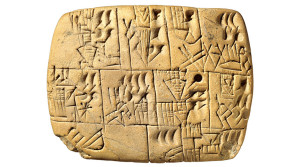Early humans knew about advertising and branding.
“There are lots of fish here.”
“The man with the big spear is a great hunter.”
“We are a very scary tribe and you should stay away or your head will also end up on a stick.”
(Of course, being the branding experts, they didn’t need so many words. They just stuck a head on a stick and let the target audience work it out for themselves. Cavemen, it turns out, were pretty good at figuring out the subtext in a message.)
There’s a lovely talk by Genevieve von Petzinger about a common graphic language used between 30,000 and 40,000 years ago.
This common graphic language pre-dates the alphabet.
It’s pre-pre-alphabet. Before the Sumerians and their cuneiform tablets and the early Chinese and their pictograms. She’s looked at a group of common symbols found in caves all over Europe. (And noted similarities in symbols across the globe.) The findings point, very clearly, to a bunch of geometric shapes having specific, culturally-recognised, agreed-upon meanings. Across the world. Before the internet!
These are symbols that go beyond circles and squares. A range of symbols with a certain level of complexity. Not just a picture of a bird having a universal meaning of, “bird”.
Genevieve hasn’t figured out what the symbols mean. But the prevalence and spread point to a universal understanding.
Let’s be clear, it’s not an alphabet.
She does point out that early writing and early alphabets didn’t come out of a vacuum. And, while Frau Von Petzinger doesn’t claim these symbols are the forerunners of modern alphabets, she makes the point the development of alphabets (around 5,000 years ago) evolved from stylised images.
Stylised images with specific, culturally-recognised, agreed-upon meanings.
If the Sumerians and the early Chinese and the Egyptians with their hieroglyphs didn’t create their alphabet or their language in a vacuum, why on god’s green earth do we feel the need to?
If Ice Age humans could see the need for assigning specific, culturally-recognised, agreed-upon meanings to symbols, why can’t we.
Why does the word “brand” seem to have a hundred different meanings.
None of them wrong. But none of them exactly the same.
I listened to someone outlining their theory on brands last week and it was like he was trying to describe string theory to babies.
It’s all about reputation and selling.
Isn’t it?
And, in today’s information overloaded world, that’s hard enough.
Why do we need to make it harder by trying to reinvent the alphabet every time we need to sell something?


Leave A Comment